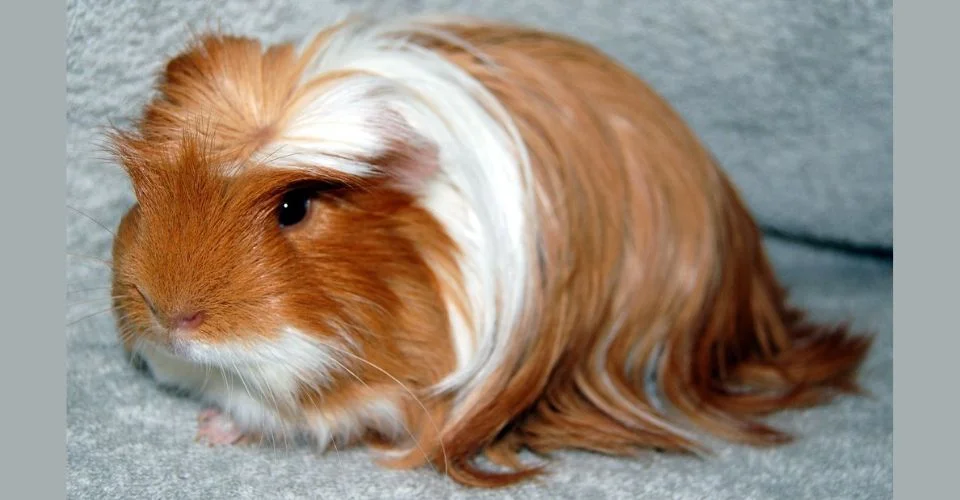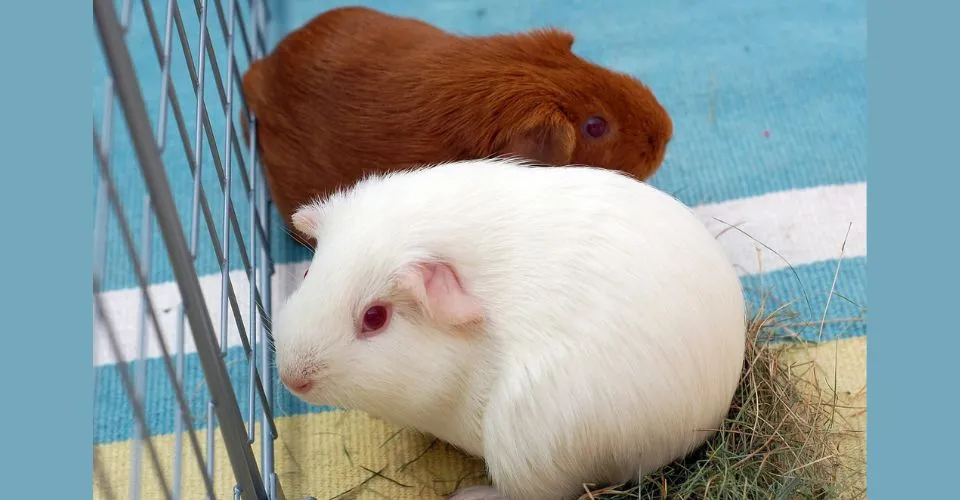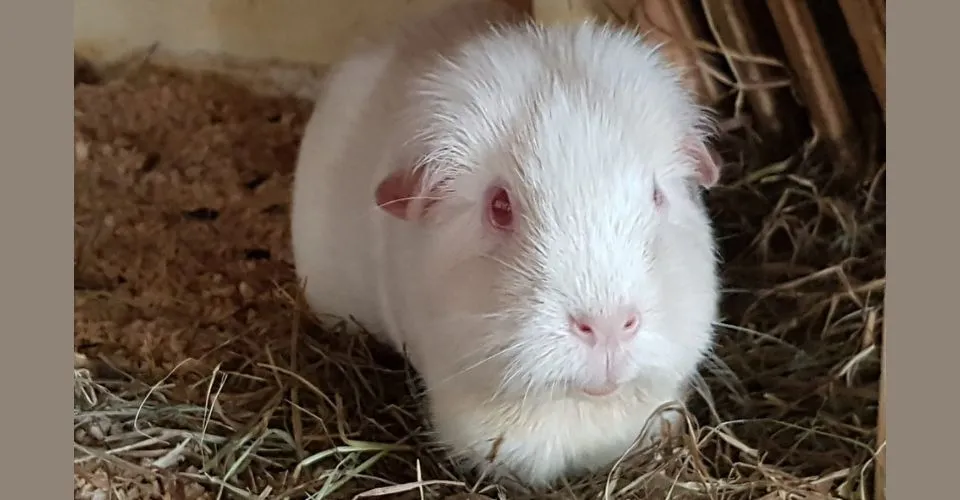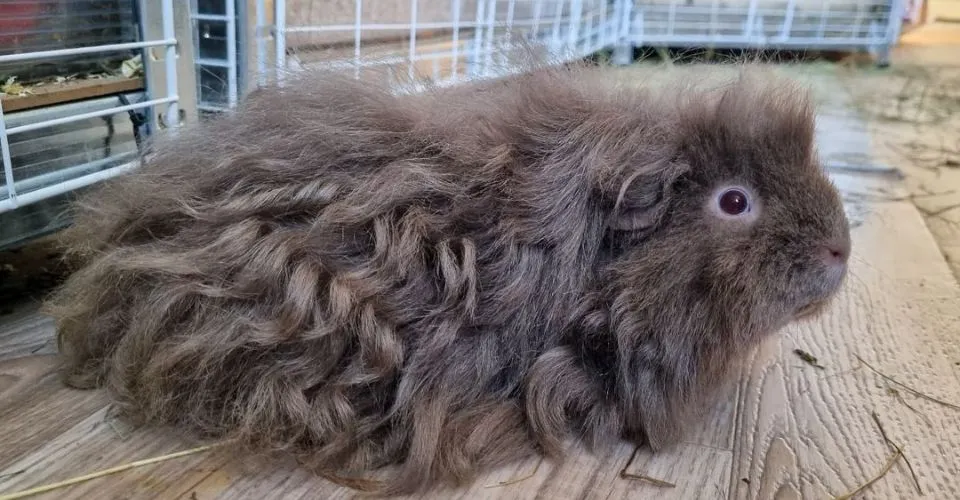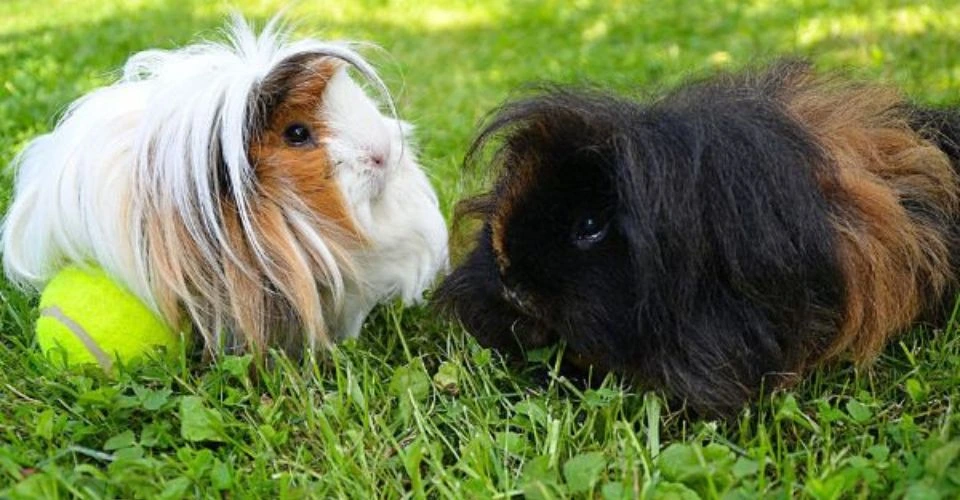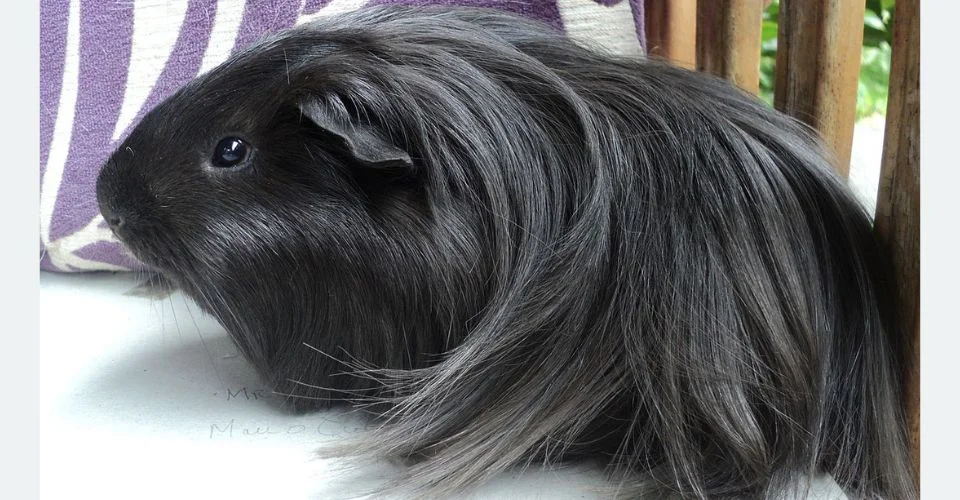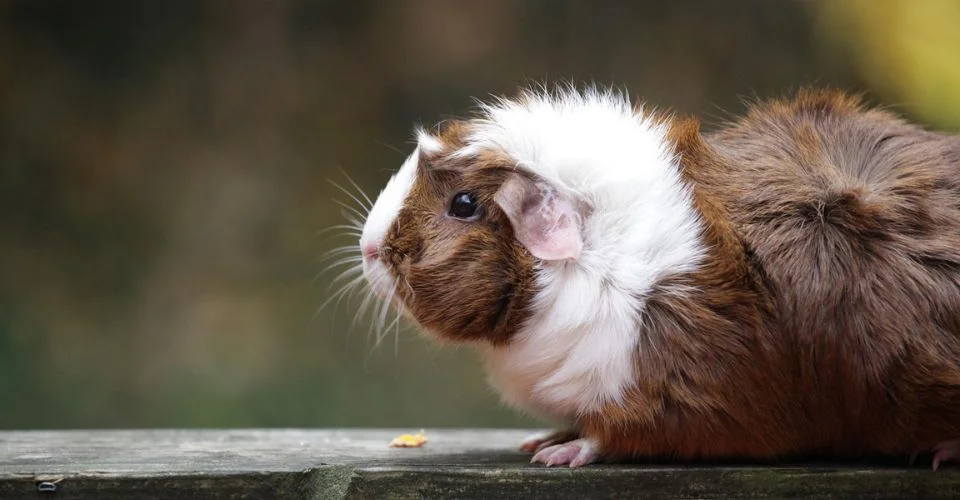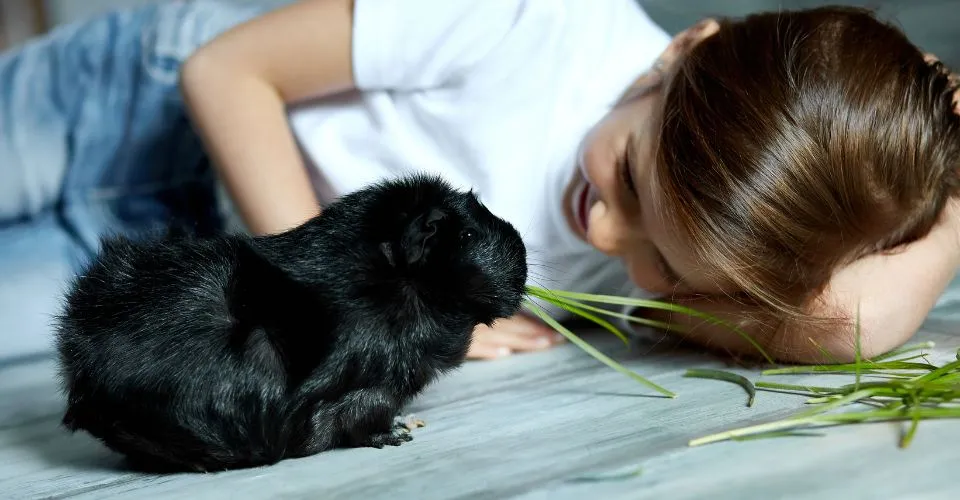Developed in England by the crossbreeding of Silkie guinea pigs with English Crested guinea pigs, Coronet guinea pigs are beautiful, long-haired guinea pigs and are often called “English Crested Silkies/Shelties.” Coronet guinea pigs have a striking resemblance to the Silkies. It would be hard to tell them apart from each other if Coronet guinea pigs didn’t have the characteristic coronet or rosette in the middle of their heads.
These adorable fluffballs never fail to captivate the attention of the viewers. Our guess is that Coronet guinea pigs have wooed your heart or that of your child as well, and now you are looking to get yourself or your child a Coronet guinea pig. But before you go and bid on a Coronet guinea pig for sale, we advise you to familiarize yourself with this guinea pig breed. They are not one of the guinea pig breeds for first-time, inexperienced owners or small children. If you are a novice guinea pig owner, we advise you to forget about the Coronet guinea pig and instead consider the American guinea pig—they don’t have the exotic-looking long fur but are equally or a bit friendliest and cutest.
Whatever the case is, you should continue reading to learn if a Coronet guinea pig would make a good choice for you or not.
Coronet Guinea Pig
Coronet guinea pigs are longhaired guinea pigs with a coronet or a rosette of hair on their forehead. Besides the coronet on the forehead, Coronet guinea pigs are like Silkies with a smooth, longhaired coat growing backward on their bodies. They make wonderful pet guinea pigs but let’s read and discover if they would make a good fit for you or not.
| Coronet Guinea Pig Breed Overview | |
| Scientific Name | Cavia porcellus |
| Other Names | English Crested Silkies, |
| Origin | England |
| Length | 8 to 16 inches |
| Weight | 1.5 to 3 pounds |
| Lifespan | 7 to 8 years |
| Coat Color | Variety of colors including cream, lilac, red, slate, golden, black, etc. |
| Maintenance | High-maintenance |
| Diet | Herbivores (timothy hay) |
| Cage | At least 30×60 inch enclosure |
| Temperament | Easy-going, social, playful |
| Suitable for | Experienced guinea pig owners |
| Coronet Guinea Pig Scoreboard | |
| Friendly | 4.5/5 |
| Like to be held | 4/5 |
| Grooming Requirements | 5/5 |
| Energetic | 5/5 |
| Good with other Guinea Pigs | 5/5 |
| Good with Children | 4/5 |
Coronet Guinea Pig History
Coronet guinea pig is a relatively new guinea pig breed. They were developed by the crossbreeding of English Crested guinea pigs with Silkie guinea pigs in the early 1970s in England. Mesmerized by the long hairs and a swirl on top of their heads, in the late 1970s, guinea pig breeders in the United States had developed their own Coronet guinea pig by crossing Silkies with anon-conforming White Crested guinea pigs. However, it was not until 1998 that the American Rabbit Breeders Association officially recognized Coronet guinea pigs as a separate breed.
Coronet Guinea Pig Personality and Temperament

Coronet guinea pigs are affectionate and friendly like most guinea pig breeds. They are very sociable and love to interact with both their loving owners and cage companions alike. They love to be gently handled and stroked by their loving owners. They also love snuggling up with their cage mates. Like other guinea pig breeds, Coronet guinea pigs are social creatures and don’t like to be kept in isolation. So, it would be best if you keep them in pairs.
The docile and easygoing nature of Coronet guinea pigs makes them an excellent choice for pet guinea pigs. They would be perfect for children and inexperienced guinea pig owners but given the significant grooming challenges associated with the breed, they only suit experienced guinea pig owners.
Coronet Guinea Pig Appearance
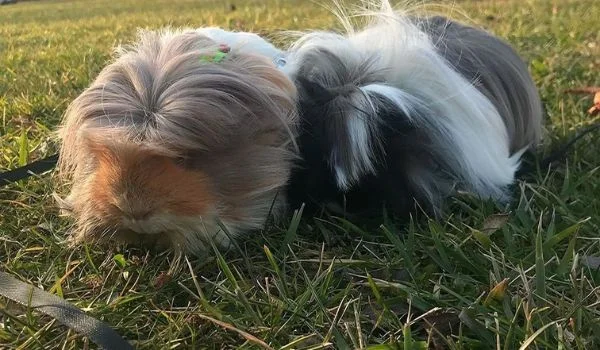
Coronet guinea pigs are longhaired guinea pigs with a striking resemblance to Silkie guinea pigs as they inherit the characteristic coat of Silkies. Their fur flows against their bodies. But unlike Silkies, they have a rosette or coronet “small crown” of hair on their forehead.
Size
Coronet guinea pigs are average-sized guinea pigs with their length ranging between 8 to 16 inches and weighing around 1.5 to 3 pounds. But like most other guinea pig breeds, Coronet guinea pigs are sexually dimorphic, which means that male Coronet guinea pigs are larger in size than their female counterparts.
Coat
Coronet guinea pigs inherit the characteristic longhaired silky coat of Sheltie guinea pigs. Coronet guinea pigs come in a wide variety of colors and color combinations, with cream, lilac, red, slate, golden, black, etc., being the most common.
Similarly, unlike White Crested guinea pigs, Coronet guinea pigs can have a crest of various colors, mostly different from the color of their coat.
How to Care for a CoronetGuinea Pig?
Like other longhaired guinea pig breeds, Coronet guinea pigs require a lot of care and grooming. Continue reading to learn if you would be able to care for a Coronet guinea pig or would it be overwhelming for you.
Feeding
Coronet guinea pigs don’t really have any special dietary requirements—they can live a happy and healthy life feeding on the basic guinea pig diet. You will have to provide them with a constant supply of timothy hay. It not only provides them with the dietary fibers that are imperative for an effective bowel movement but also wears down their always-growing teeth.
Like other guinea pigs, Coronet guinea pigs cannot make their own vitamin C and thus need it in their diet. While you can feed them guinea pig-safe fresh fruits and vegetables that contain vitamin C to make up for their vitamin C requirements. But as just eating veggies won’t make for their requirements, you will have to provide vitamin C supplements. You should also provide food pellets fortified with vitamin C to your Coronet guinea pig.
Grooming
Coronet guinea pigs will present you with a number of grooming challenges. So brace yourself.
Daily Coat Brushing
Thanks to the longhaired coat of Coronet guinea pigs, you will have to brush their coat daily to keep it free of knotting and matting. It is strongly advised that you get your guinea pig used to grooming sessions when they are young. You can also provide tasty guinea pig treats to your guinea pig at the end of grooming sessions to keep the grooming sessions interesting.
You should be extra careful when your Coronet guinea pig has developed mats or knots, as you may end up hurting your guinea pig without knowing it. These grooming sessions are undoubtedly a lot of work, but you can look at them as an essential bonding period between you and your furball.
Weekly Baths
Besides brushing, you will have to bathe your Coronet guinea pig regularly. It is advised that you bathe your Coronet guinea pig once a week. Coronet guinea pigs don’t like their bathing sessions, so bathing them would be an arduous task, requiring a lot of patience and kindness on your part. You should keep in mind that bathing is necessary for longhaired guinea pigs like Coronet, so if it is not possible to bathe them weekly, you should try to bathe guinea pigs at least twice or thrice a month.
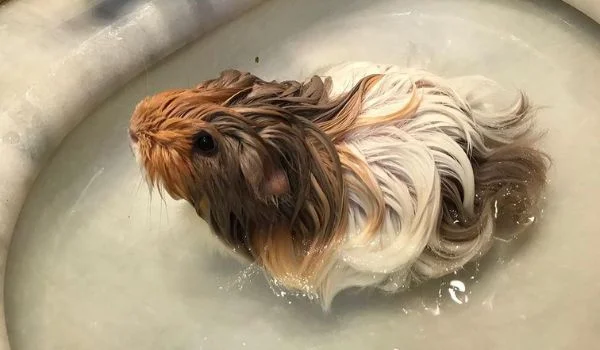
Where brushing would help remove debris trapped in their long fur, bathing would help remove feces and urine ensnared in their fur, making them prone to matting and knotting.
As soon as you get all the shampoo out of their furry coat, you should dry them using a soft dry towel.
Regular Hair Trimming
Unless you are planning on taking your Coronet guinea pig to shows, you should keep their hair trimmed. It would significantly reduce the chances of knotting and matting and make brushing sessions easier. Short hairs would also mean a low chance of dirt, moisture, and debris trapped in their coat. While a trip to a local groomer could cost you a bit, you can learn to trim your guinea pig’s hair yourself.
Regular Nail Clipping
Like all other guinea pig breeds, Coronet guinea pigs also need their nails to be trimmed regularly. Overgrown nails are hurtful to your guinea pigs and increase the risk of many serious health issues like bumblefoot. Besides, guinea pig nails start to curl up without regular clipping, which makes it difficult and hurtful for them to move around and increases the risk of guinea pig nail getting ripped off.
So either take your Cornet guinea pig to a professional groomer or clip their nails yourself, regularly—once or twice a month. If you have a younger or an older guinea pig that is being fed a nutrient-rich diet, it would require more frequent nail clippings as their nails grow faster.
To ensure that nail clipping sessions end without an accident, you should take help from a friend. One person should gently hold the guinea pig, comfortingly restricting its movement while you clip its nails. The person may also use treats to keep the guinea pig in a pleasant mood for the clipping session.
Enclosure Set-up
Coronet guinea pigs are quite active and like to roam around. So a small cage won’t be a good fit for your Coronet guinea pig. It is suggested that you have as large a guinea pig cage as large you can afford. However, at minimum, the guinea pig cage for your Coronet guinea pig should be 30×60 inches. If you are going to house more than one guinea pig, you should provide some extra space for it and also place an extra guinea pig hide for each guinea pig.
You should also keep in mind that your Coronet is not going to spend all day long snoozing in their cages. They would require at least an hour or so outside their cage. We advise you to have a close guinea pig-safe room in which your Coronet guinea pig can roam around and safely explore. You can interact with your guinea pig in this room and make sure that no pet (if you have any cat or dog) enters this room when you piglet it out.
| How to Keep Your Coronet Guinea Pig Happy and Healthy? |
| · Provide them with a spacious and safe indoor cage with a separate hide for each guinea pig · Provide a constant supply of clean and fresh water · Provide a constant supply of fresh and quality timothy hay · Throw in some fresh guinea pig-safe fruits and veggies to keep your diet interesting · Provide guinea pig food pellets fortified with vitamin C · Provide the vitamin C supplements · Brush their coat daily using a stainless comb · Bathe them twice or thrice a month; weekly baths would be ideal · Trim your Coronet’s fur regularly if you are not planning on presenting them in shows · Clip their nails once or twice a month · Check their ears for any signs of discharge buildup or ear infection · Provide your Coronet guinea pigs some outdoor time to play and exercise · Provide your Coronet with some guinea pig toys to keep them busy. |
| Should You Get a Coronet Guinea Pig? | |
| Pros | Cons |
| Adorable and cute | High maintenance |
| Make a perfect guinea pig pet and rock on show stages | The coat requires daily brushing and weekly baths |
| No serious health issue | Prone to ear infection due to long fur |
Coronet Guinea Pig Names
Looking for a name for your new Coronet guinea pig?
Here is a brief list of guinea pig names to get you started.
| Fuzzy | Oreo | Clover | Anarchy |
| Fluffy | Cupcake | Tofu | Chaos |
| Mist | Meatball | Basil | Jedi |
| Pillow | Waffles | Curry | Lucifer |
| Furlong | Muffin | Pepper | Jaguar |
Didn’t find a name for your one-of-a-kind piglet?
Check out: Guinea Pig Names, Boy Guinea Pig Names, Girl Guinea Pig Names, and Cute Guinea Pig Names. While going through the list of names, you can write down names that you might think would be a good fit for you. Then you can go on calling your fluffball with each name a few times, and if it does not sound good, move on to the next name.
As a rule of thumb, small names—of no more than two syllables—work best.
